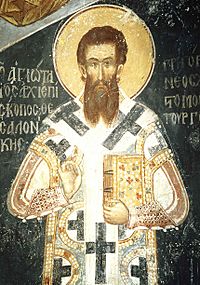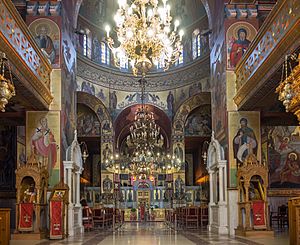Gregory Palamas facts for kids
Quick facts for kids SaintGregory Palamas |
|
|---|---|

Painting of Saint Gregory in Monastery of Vatopaidi, Mount Athos, Greece. The captions call him, among other titles, Νέος Χρυσόστομος: A New Chrysostom.
|
|
| Archbishop of Thessalonica, Church Father, Pillar of Orthodoxy | |
| Born | 1296 Constantinople, (modern-day Istanbul, Turkey) |
| Died | 14 November 1357 (aged 60-61) Thessaloniki, Macedonia (modern-day Greece) |
| Venerated in | Eastern Orthodox Church Eastern Catholic Churches Anglican Communion |
| Canonized | 1368, Constantinople by Patriarch Philotheos of Constantinople |
| Major shrine | Thessaloniki |
| Feast | 14 November, Second Sunday of Great Lent |
| Attributes | Long, tapering dark beard, vestments of a bishop, Gospel Book or scroll, right hand raised in benediction |
| Influenced | Nilus Cabasilas, Gennadius Scholarius, Nicodemus the Hagiorite, Sophrony of Essex, John Meyendorff, Seraphim Rose |
Gregory Palamas (Greek: Γρηγόριος Παλαμᾶς; c. 1296 – 1359) was a Byzantine Greek theologian and Eastern Orthodox cleric of the late Byzantine period. A monk of Mount Athos (modern Greece) and later archbishop of Thessaloniki, he is famous for his defense of hesychast spirituality, the uncreated character of the light of the Transfiguration, and the distinction between God's essence and energies (i.e., the divine will, divine grace, etc.). His teaching unfolded over the course of three major controversies, (1) with the Italo-Greek Barlaam between 1336 and 1341, (2) with the monk Gregory Akindynos between 1341 and 1347, and (3) with the philosopher Gregoras, from 1348 to 1355. His theological contributions are sometimes referred to as Palamism, and his followers as Palamites.
Gregory has been venerated as a saint in the Eastern Orthodox Church since 1368. Within the Catholic Church, he has also been called a saint; Pope John Paul II repeatedly called Gregory a great theological writer. Since 1971, the Melkite Greek Catholic Church has venerated Gregory as a saint. Some of his writings are collected in the Philokalia, and since the Ottoman period, the second Sunday of Great Lent is dedicated to the memory of Gregory Palamas in the Orthodox Church and Ukrainian Greek Catholic Church. The Byzantine Synodikon of Orthodoxy also celebrates his memory and theology while condemning his opponents, including some anti-Palamites who flourished after Gregory's death.
Early life
Gregory was born in Constantinople around the year 1296. His father, Constantine, was a courtier of the Byzantine Emperor Andronikos II Palaiologos (1282–1328), but died when Gregory was still young. The Emperor himself took part in the raising and education of the fatherless boy and hoped that the gifted Gregory would devote himself to government service, but Palamas chose monastic life on Mt. Athos. Gregory's mother (Kalloni) and siblings (Theodosios, Makarios, Epicharis, and Theodoti) would also embrace monasticism, and the entire family was canonized by the Ecumenical Patriarchate of Constantinople in 2009.
Before leaving for Mt. Athos, Gregory received a broad education at the University of Constantinople, including the study of Aristotle, which he would display before Theodore Metochites and the Emperor.
Monastic life
Despite the Emperor's ambitions for him, Gregory, then barely 21 years old, withdrew to Mount Athos in the year 1316 and became a novice there in the Vatopedi monastery under the guidance of the monastic Elder St Nicodemos of Vatopedi. Eventually, he was tonsured a monk, and continued his life of asceticism. After the demise of the Elder Nicodemus, Gregory spent eight years of spiritual struggle under the guidance of a new Elder, Nicephorus. After this last Elder's repose, Gregory transferred to the Great Lavra of St. Athanasius the Athonite on Mount Athos, where he served the brethren in the trapeza (refectory) and in church as a cantor. Wishing to devote himself more fully to prayer and asceticism he entered a skete called Glossia, where he taught the ancient practice of mental prayer known as "prayer of the heart" or hesychasm.
In 1326, because of the threat of Turkish invasions, he and the brethren retreated to the defended city of Thessaloniki, where he was then ordained a priest. Dividing his time between his ministry to the people and his pursuit of spiritual perfection, he founded a small community of hermits near Thessaloniki in a place called Veria.
He served for a short time as Abbot of the Esphigmenou Monastery but was forced to resign in 1335 due to discontentment regarding the austerity of his monastic administration.
Later years
Palamas's opponents in the hesychast controversy spread slanderous accusations against him, and in 1344 Patriarch John XIV imprisoned him for four years. However, in 1347 when Patriarch Isidore came to the Ecumenical Throne, Gregory was released from prison and consecrated as the Metropolitan of Thessalonica. However, since the conflict with Barlaam had not been settled at that point, the people of Thessalonica did not accept him, and he was forced to live in a number of places. It was not until 1350 that he was able to occupy the episcopal chair. In 1354, during a voyage to Constantinople, the ship he was in fell into the hands of Turkish pirates; he was imprisoned and beaten. He was obliged to spend a year in detention at the Ottoman court where he was well treated. Eventually his ransom was paid and he returned to Thessaloniki, where he served as archbishop for the last three years of his life.
Death and canonization
Palamas died in 1357 or 1359. His dying words were, "To the heights! To the heights!" He was canonized a saint of the Eastern Orthodox Church in 1368 by Patriarch Philotheos of Constantinople, who also wrote his Vita and composed the service which is chanted in his honour. His feast day is celebrated twice a year, on 14 November, the anniversary of his death, and on the Second Sunday of Great Lent, because Gregory's victory over Barlaam is seen as a continuation of the Triumph of Orthodoxy, i.e., the victory of the Church over heresy, celebrated the previous Sunday.
Gregory's relics rest in the Church of Saint Gregory Palamas in Thessaloniki.
Hymns
Troparion (Tone 8)
- O light of Orthodoxy, teacher of the Church, its confirmation,
- O ideal of monks and invincible champion of theologians,
- O wonder-working Gregory, glory of Thessaloniki and preacher of grace,
- always intercede before the Lord that our souls may be saved.
Kontakion (Tone 8)
- Holy and divine instrument of wisdom,
- joyful trumpet of theology,
- together we sing your praises, O God-inspired Gregory.
- Since you now stand before the Original Mind, guide our minds to Him, O Father,
- so that we may sing to you: "Rejoice, preacher of grace."
Works
- Patrologia Graeca, vols. 150, 151
- Philokalia
- Primary works translated into English
- The Triads (Classics of Western Spirituality Series) (ISBN: 0-8091-2447-5)
- Philokalia, Volume 4 (ISBN: 0-571-19382-X)
- Saint Gregory Palamas: The Homilies, (The Complete Homilies Translated into English - Published in 2009) (ISBN: 0977498344)
- Homilies of Saint Gregory Palamas, Vol. 1 (ISBN: 1-878997-67-X)
- Homilies of Saint Gregory Palamas, Vol. 2 (ISBN: 978-1-878997-68-5)
- Treatise on the Spiritual Life (ISBN: 1-880971-05-4)
- The One Hundred and Fifty Chapters (ISBN: 0-88844-083-9)
- Dialogue Between an Orthodox and a Barlaamite (ISBN: 978-1-883058-21-0)
See also
 In Spanish: Gregorio Palamás para niños
In Spanish: Gregorio Palamás para niños
- Tabor Light
- Mount Athos
- Gregory Acindynus
- Christian mysticism
- The Ascetical Homilies of Isaac the Syrian, a 7th-century hesychastic text



